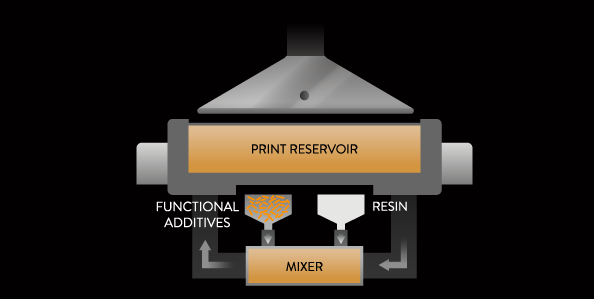Fortify is one of a number of startups that are developing unique technologies for 3D printing composites. While we await the commercial release of the company’s digital light processing (DLP) system for 3D printing composite materials, Fortify has released more information about when that release is to come, along with news of a new product, its Continuous Kinetic Mixing (CKM) system.
Fortify’s Fluxprint method upgrades traditional DLP technology through the use of a proprietary magnetic system. As illustrated in the video below, Fluxprint relies on printing with resins loaded with reinforcement material (e.g., fibers, ceramics, metals) that have been coated in a magnetic material. During the printing process, a magnet within Fortify’s printer orients these materials in an optimized manner depending on the application. By combining the embedded additives with the proper orientation, the technology can improve strength, stiffness, toughness, wear, and heat deflection temperature, and electrical properties
The CKM system is a material mixing module that ensures that the additives within loaded photopolymers are uniformly distributed while preventing sedimentation and aggregation. While this module will be unique to Fortify’s 3D printers, this sort of technology may be crucial to any sort of vat photopolymerization 3D printer that uses loaded resins. We’ve covered stories about a variety of photopolymers with specialty additives. Perhaps a similar mixing process could facilitate their printing and increase the adoption of such materials.
With the CKM announcement, Fortify has also stated that it is expanding its printing and manufacturing capacity with the goal of shipping its first printers to select customers this summer. Up until now, the company has been printing parts for customers, specifically for the production of tooling for injection molding applications.
Through the use of proprietary ceramic reinforcement materials, Fortify has been able to print molds with complex geometries and enhanced physical properties for plastic injection molding. The company has since expanded this capability to metal injection molding (MIM), blending ceramic fibers with resin to create parts that can weather the extreme heat and pressure of MIM.
Chris Aiello, Technical Sales Manager at Alpha Precision Group, said of this new capability, “For years our customers have been asking us for a better way to prototype parts with our production metal injection molding process. Speed, dimensional accuracy, and production intent processes are critical for our customer’s development efforts. Fortify finally showed us a tooling solution that holds up to our MIM process, and checks all the boxes for our customers requirements.”
It’s interesting to note that Fortify is framing the CKM system as a module, as is the case for its Flexprint “fiber alignment module”. We’ll have to see how the modularity of Fortify’s products affects the company’s business and technological strategy. This could mean the need to purchase or lease specific modules separately from the printer itself. Or it could mean that Foritfy plans to release a number of interesting modules over time that may be swapped or included into a broad portfolio of printing systems intended by the startup.
The concept of modularity for tech products is a potentially exciting one, as it makes it possible to upgrade hardware more easily, without completely replacing or overhauling the entire machine. When it comes to consumer goods, modularity has been struggling. Google shelved its modular smartphone and Nascent Objects was acquired by Facebook before we could see if its modular electronics would get off the ground.
For industrial products and individual subcomponents, hardware modules may be easier to pull-off. Swappable printheads, for instance, are common. We’re still awaiting some of the hardware modules related to quality assurance and automation alluded to by Origin when it first unveiled its programmable photopolymerization process. Carbon also said that it would be developing modular hardware to interface with Carbon Connectors built into its equipment. When and if modular hardware becomes a thing has yet to be seen, but if it does, it could have an important impact on the disposability/obsolescence mindset currently exhibited by tech companies.
